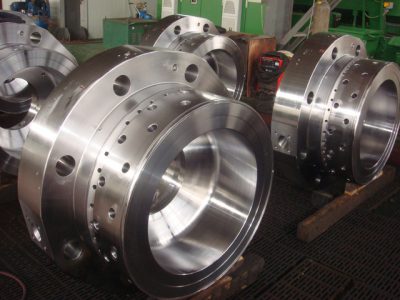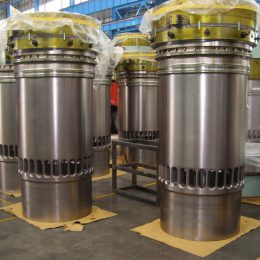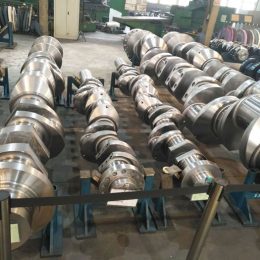
Cylinder Head Cover
The Cylinder Head Coveris an essential part of a marine diesel engine. Its primary function is to seal the top of the cylinder and create a combustion chamber. The cylinder cover is subject to high pressure, temperature, and stress, making it a critical component of the engine.
- 90101-163-102 o-ring(Fpm)
- 90101-163-114 water guide jacket
- 90101-163-138 nut
- 90101-163-151 distance pipe
- 90101-163-163 stud for fuel valve
- 90101-163-18 screw
- 90101-163-187 set screw
- 90101-163-31 protective cap
- 90101-163-43 hydraulic nut
- 90101-163-55 stud for exhaust valve
- 90101-163-79 nut
- 90101-163-80 stud for starting valve
- 90101-163-92 cyliner cover
Construction of Marine Diesel Engine Cylinder Head Cover
The Cylinder Head Cover is typically made of cast iron or steel, and it is designed to withstand high temperature and pressure. The cover has a circular shape and is bolted to the cylinder block. It is fitted with valves, injectors, and other components required for the engine’s operation. The cover is also equipped with a sealing gasket to prevent gas leaks.
Function of Marine Diesel Engine Cylinder Head Cover
The Cylinder Head Cover serves several functions, including:
Creating a Combustion Chamber
The Cylinder Head Cover seals the top of the cylinder, creating a combustion chamber. It contains the fuel injector and the exhaust valve and ensures that the combustion process takes place correctly.
Controlling the Valves
The Cylinder Head Cover houses the valves, which control the intake of air and fuel and the exhaust of gases.
Supporting the Fuel Injector
The fuel injector is mounted on the Cylinder Head Cover and is responsible for delivering fuel to the combustion chamber.
Maintenance of Marine Diesel Engine Cylinder Head Cover
Proper maintenance of the cylinder cover is crucial to ensure the optimal performance of the engine. Here are some maintenance tips:
Regular Inspection
Regularly inspect the cylinder cover for signs of wear and tear, cracks, or leaks.
Tightening Bolts
Ensure that the bolts holding the cylinder cover in place are tightened to the manufacturer’s specifications.
Replacing Gaskets
Replace the cylinder cover gasket regularly to prevent gas leaks.
Cleaning
Clean the cylinder cover regularly to remove dirt, oil, and other contaminants.
Common Issues with Marine Diesel Engine Cylinder Head Cover
Several issues can arise with the cylinder cover. Some of the most common ones include:
Gas Leakage
If the cylinder cover gasket is damaged or worn out, gas can escape, resulting in reduced engine performance.
Cracks
Cracks can occur in the cylinder cover due to high pressure and temperature, leading to engine failure.
Warping
Warping of the cylinder cover can occur due to excessive heat, causing the cover to lose its shape and compromising engine performance.
Causes of Cylinder Head Cover Cracking
Cylinder covers endure high levels of stress during operation as a result of thermal and pressure stresses caused by combustion. These stresses are added to the stress caused by initial head tensioning. The following factors may further increase these stresses:
- Excess cylinder combustion pressures that increase the mechanical or pressure stress on the head.
- Excess cylinder thermal stress caused by high cylinder temperatures, incorrect cylinder cooling, or insufficient cooling water treatment. This leads to larger temperature differences across the cylinder head material, resulting in larger thermal stresses.
- Incorrect cylinder cover assembly, such as over-tensioning. This increases the initial tension, resulting in higher total stress on the cylinder cover. This could produce cracks in the highly stressed areas of the cylinder cover.
How to Prevent Cylinder Head Cover Cracking
Correct operation and maintenance of the engine can reduce the possibility of cracking by eliminating the above causes.
- Monitor cylinder combustion pressure using indicator cards or peak pressure readings. Engine load can also be measured online through exhaust temperatures and turbocharger revolutions, and compared to engine model curves or test bed readings. The engine room staff should monitor these readings and ensure that the maximum levels given are not exceeded.
- Closely monitor the temperature of the cylinder cooling to ensure that the temperatures are not excessive (leading to liner overheating) or too cold (leading to higher temperature gradients across the liner wall and increased thermal stress). Temperature monitoring should be done through control room gauges and alarm settings.
- Initial tensioning of the cylinder head should be carried out according to the recommended hydraulic tension or torque settings. The gauges used to determine these levels must be calibrated regularly.
- Maintain the reserve of cooling water nitrates to reduce scaling or fouling of the cylinder cover’s heat transfer surfaces and to maintain the fatigue life of the covers.
FAQs
- What is the function of the marine diesel engine cylinder cover?
- The cylinder cover creates a combustion chamber, controls the valves, and supports the fuel injector.
- What is the cylinder cover made of?
- The cylinder cover is typically made of cast iron or steel.
- What are the common issues with the cylinder cover?
- The common issues include gas leakage, cracks, and warping.
- How can I maintain my marine diesel engine cylinder cover?
- You can maintain the cylinder cover by regularly inspecting it, tightening bolts, replacing gaskets, and cleaning it.











